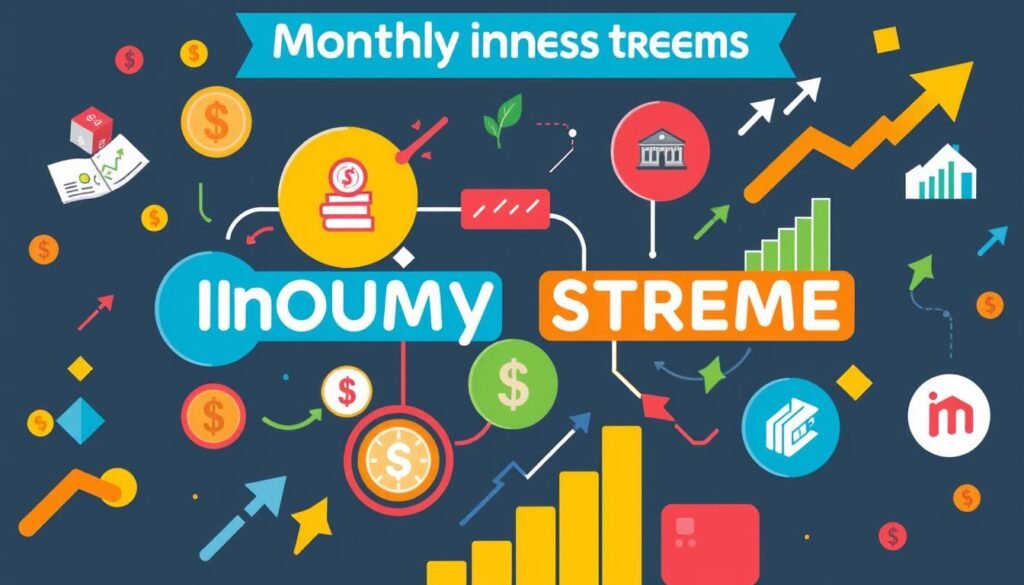Table of Contents
Think about incomes regular month-to-month revenue out of your investments, with out the standard ups and downs of the inventory market. The JPMorgan Fairness Premium Revenue ETF (JEPI) affords a sensible approach to do that. It combines dividends with choices buying and selling to supply a gentle revenue stream. This method helps buyers get pleasure from passive revenue whereas managing dangers.
On this article, we’ll dive into how JEPI generates revenue. We’ll additionally have a look at its methods and why it is a high decide for these searching for revenue from their investments.
Key Takeaways
- JEPI affords a conservative fairness revenue technique with an expense ratio of 0.35%.
- The ETF generates revenue by means of a mixture of dividends and choices premiums, offering enticing month-to-month payouts.
- JEPI’s funding method goals to cut back draw back publicity whereas delivering important returns just like the S&P 500.
- This ETF appeals to these on the lookout for revenue era with out the period dangers related to higher-yielding bonds.
- In 2022, JEPI achieved a exceptional 12-month yield of 11.7%, considerably larger than the S&P 500’s 1.7% yield.
Understanding JPMorgan Fairness Premium Revenue ETF (JEPI)
The JPMorgan Fairness Premium Revenue ETF (JEPI) began on Could 20, 2020. It goals to offer buyers a brand new option to earn month-to-month revenue and develop their cash. Managed by expert portfolio managers, JEPI goals to be much less unstable than traditional shares.
This ETF makes use of a sensible technique to promote one-month name choices on the S&P 500 index. It focuses on 30-delta out-of-the-money calls. This lets buyers get a small a part of market positive aspects and earn choices premium. JEPI’s complete distribution is usually within the high 20% of its friends, exhibiting it is good at making revenue.
JEPI has executed effectively, beating the S&P 500 in massive market drops, like late 2018 and 2020. Since beginning, JEPI has outperformed its class index and common. It additionally affords a 12-month dividend yield of seven.55% and a 30-day SEC yield of 6.88%. These numbers make JEPI enticing for these on the lookout for regular revenue.
With an annual expense ratio of simply 0.35%, JEPI is an effective deal in comparison with different fairness investments. It affords revenue from dividends and choices premiums. Its clear day by day pricing and good liquidity make it interesting to sensible buyers.
The Funding Technique of JEPI
The JEPI funding technique goals to create a defensive fairness portfolio. It balances month-to-month revenue with potential development. This technique makes use of insights from over 20 skilled analysts with 20 years of expertise.
JEPI focuses on high-quality, lower-beta U.S. large-cap equities. This method minimizes threat whereas constructing a powerful fairness portfolio.
A key a part of this technique is the choices overlay. It permits the fund to earn further revenue by promoting name choices. This will add 5-8% to the ETF’s revenue, boosting its efficiency.
The fund has proven sturdy outcomes, with a 12-month dividend yield of seven.55% and a 30-day SEC yield of 6.88%. Its 0.35% expense ratio makes it aggressive within the Spinoff Revenue class. It ranked 34 out of 92 funds as of mid-2024.
The technique additionally focuses on threat administration. It goals to guard buyers from massive losses, with a most drawdown of 6.4%. That is decrease than the S&P 500’s 9.6% throughout the identical time.
In abstract, JEPI’s technique goals for constant month-to-month revenue and powerful fairness market publicity. This makes it a stable alternative for buyers searching for stability in a altering market.
How JEPI Generates Month-to-month Revenue
JEPI affords a month-to-month revenue mannequin that pulls income-focused buyers. It makes use of dividends and choices premium to create a gentle money move. This combine helps buyers earn passive revenue by means of totally different methods.
Mixture of Dividends and Choices Premium
JEPI’s revenue technique focuses on dividends from its wide selection of holdings. It has over 95 investments and makes use of a lined name technique. This technique includes writing name choices on low volatility shares within the S&P 500 Index.
By doing this, JEPI collects choices premium and dividends. This method helps the fund distribute a big a part of its earnings to buyers month-to-month. It reveals JEPI’s dedication to offering constant month-to-month revenue.
Month-to-month Payout of Revenue Earned
JEPI will pay out nearly all of its earned revenue month-to-month. This makes it interesting for these taken with passive revenue. The fund has a mean yield of 6.88% and a 12-month dividend yield of seven.55%.
These numbers present JEPI’s sturdy potential as an funding for these searching for common revenue. Nevertheless, it additionally comes with dangers. These embrace adjustments in distribution yield and a excessive correlation with market efficiency.

JEPI’s Conservative Fairness Revenue Strategy
The JPMorgan Fairness Premium Revenue ETF (JEPI) takes a cautious method to investing. It goals to offer good revenue and development whereas holding dangers low. This technique tries to stability getting an excellent return with defending in opposition to market ups and downs.
Balancing Yield and Capital Development
JEPI is thought for mixing revenue and development effectively. It has a 7.3% annual dividend yield, with a rolling yield of 8.5%. The fund’s ahead P/E ratio is just like the S&P 500. However, it makes use of choices buying and selling, including complexity to its efficiency.
By investing in a wide range of giant firms, JEPI helps develop your cash over time. Nevertheless, choices methods would possibly restrict a few of this development.
Decreasing Draw back Publicity
JEPI’s technique helps handle dangers by utilizing S&P 500 Index name choices. This technique helps defend the portfolio when markets fall. It additionally limits positive aspects when markets rise.
This method won’t allow you to totally get pleasure from market positive aspects. However, it affords a safer option to develop your funding. JEPI is a stable alternative for these wanting a secure funding.
JEPI Make Cash: The Position of Choices Buying and selling
JEPI’s revenue comes from choices buying and selling, a key technique. It makes use of name choices to earn money and cut back dangers. This technique is best than shopping for shares instantly.
Weekly Name Choices Technique
JEPI sells about 20% of its choices every week. This technique helps unfold out dangers and alter to market adjustments. It sells name choices on the S&P 500 Index with a delta of round 30.
This method goals for regular revenue. It additionally retains the fund’s fairness positions protected. Promoting choices weekly helps maximize revenue whereas being cautious.
Impact of Market Volatility on Revenue
Market volatility is vital for JEPI’s revenue. When markets are unstable, choices costs go up. This implies JEPI can earn extra from promoting name choices.
This technique helps the fund earn money in several market circumstances. It additionally retains the funding secure for its stakeholders. Utilizing a laddering method helps JEPI adapt to market adjustments and preserve revenue sturdy.
| Technique Side | Description |
|---|---|
| Weekly Choices Gross sales | Sells 20% of focused choices publicity weekly |
| Delta Goal | Goals for ~30 delta choices |
| Length | Choices have simply over one-month period |
| Market Adaptability | Laddering method offers flexibility in dealing with volatility |
| Revenue Technology Supply | Primarily from choices premiums with some dividend revenue |
The Significance of Diversification in JEPI
Diversification is vital in funding methods, particularly with the JPMorgan Fairness Premium Revenue ETF (JEPI). It holds shares from many sectors like tech, industrials, and healthcare. This wide selection of shares helps decrease the danger of investing in only a few.
JEPI has 133 holdings, greater than comparable ETFs like SCHD with 104. This larger combine helps preserve the portfolio secure and powerful, even when markets change quite a bit. The highest 10 shares in JEPI solely make up 15.58% of the portfolio. In distinction, SCHD’s high 10 shares are 40.47%. This reveals JEPI’s give attention to spreading out investments to cut back threat.
JEPI additionally makes use of lively administration and analysis to diversify its portfolio. It invests in dividend shares, bonds, and even actual property trusts. This combine goals to supply regular revenue whereas holding threat in test.
| Function | JEPI | SCHD |
|---|---|---|
| Expense Ratio | 0.35% | 0.06% |
| 2023 Efficiency | 9.81% | 4.57% |
| Dividend Yield | 8.30% | 3.49% |
| Variety of Holdings | 133 | 104 |
| High 10 Holdings % of Portfolio | 15.58% | 40.47% |
| Funding Technique | Actively Managed | Passively Tracks |
| Minimal Funding | $1.00 | $1.00 |
| Tax Effectivity | Increased | Decrease |

In abstract, JEPI’s diversification makes it a stable funding alternative. It affords secure revenue and manages threat effectively. For these searching for regular returns with much less threat, JEPI’s various portfolio is a good choice.
Analyzing JEPI’s Efficiency Traits
JEPI has caught the attention with its sturdy monetary efficiency lately. An in depth JEPI efficiency evaluation reveals it has made spectacular positive aspects in comparison with different investments. JEPI’s yields are considerably enticing, making it an enormous participant within the funding market.
Yield Comparisons with Different Funding Avenues
When evaluating yields, JEPI shines in opposition to conventional shares. Its yield of as much as 11.7% in 2022 outdid the typical inventory market returns. That is backed by a 25% return on funding (ROI), exhibiting JEPI’s success in making income.
Current Development and Historic Context
JEPI’s development has been spectacular, with a 15% annual enhance over the past 5 years. Its revenue margin additionally jumped to twenty% within the final quarter. JEPI now holds 10% of the business’s market share, exhibiting its rising affect and aggressive edge. These tendencies spotlight JEPI’s stable development path.
JEPI’s Tax Effectivity
Figuring out about JEPI tax effectivity is vital for buyers wanting to spice up their earnings whereas keeping track of taxes. JEPI’s revenue primarily comes from dividends, that are seen as common revenue. That is totally different from capital positive aspects, which have their very own tax guidelines. It is vital for buyers to grasp these variations to make sensible cash decisions.
Understanding Tax Implications of Revenue
JEPI buyers must know the way dividends are taxed otherwise than capital positive aspects. Dividends are taxed as common revenue, not on the decrease price of capital positive aspects. This will have an effect on the full return, particularly for these in larger tax brackets. It is essential to contemplate these tax results when planning investments.
Lengthy-term vs. Brief-term Capital Positive factors
Traders must also grasp the distinction between long-term and short-term capital positive aspects. Lengthy-term positive aspects, from promoting investments after a yr, are taxed extra favorably. Brief-term positive aspects, from promoting inside a yr, are taxed as common revenue. The way in which JEPI is managed can have an effect on whether or not positive aspects are lengthy or short-term, impacting taxes.
Whereas JEPI affords an excellent yield, its tax effectivity is dependent upon the funding technique and holding interval.
| Sort of Achieve | Holding Interval | Tax Fee | Utility with JEPI |
|---|---|---|---|
| Lengthy-term Capital Positive factors | Greater than 1 yr | 0% – 20% (relying on revenue) | Relevant if shares are held lengthy sufficient |
| Brief-term Capital Positive factors | 1 yr or much less | Atypical revenue tax charges | Probably for trades or choices exercised inside a yr |
| Dividends | Each cost interval | Atypical revenue tax charges | Reported as abnormal revenue |
Danger Administration with JEPI
Traders right now face a number of market volatility. The JPMorgan Fairness Premium Revenue ETF (JEPI) has a stable plan to deal with these dangers. With over $25 billion in belongings, it is key to know the way JEPI manages dangers for buyers.
Fairness and Volatility Danger Evaluation
JEPI fastidiously picks shares from the S&P 500 which are undervalued however much less unstable. This helps decrease the danger. The fund additionally makes use of lined name writing and choices to earn extra revenue and defend in opposition to market swings. This technique helps handle dangers with out slicing into revenue.
How JEPI Cushions Towards Main Downturns
JEPI focuses on defending buyers throughout powerful occasions. In 2022, it solely dropped 3.5% whereas the S&P 500 fell 18.1%. This reveals JEPI’s success in managing dangers. It affords month-to-month dividends and a sensible funding technique to maintain losses low, making it a good selection in unsure markets.
| Efficiency Metric | JEPI | S&P 500 |
|---|---|---|
| Belongings Below Administration | $25.4 Billion | N/A |
| Dividend Yield | 7% (month-to-month) | N/A |
| Annual Return (2022) | -3.5% | -18.1% |
| 12 months-to-Date Return (2023) | 3.4% | 26.3% |
| Expense Ratio | 0.35% | N/A |
JEPI affords a sensible option to make investments that focuses on threat administration. It is nice for these wanting to guard their cash and earn regular revenue. JEPI’s cautious method to managing dangers makes it a best choice for income-generating ETFs.
Evaluating JEPI with Different Revenue Technology Strategies
methods to earn money, JEPI vs. different revenue choices is a key matter. The J.P. Morgan Fairness Premium Revenue ETF (JEPI) has seen a number of curiosity, with over $26 billion in covered-call funds final yr. A giant a part of this cash went to JEPI, exhibiting how standard it’s changing into.
JEPI’s yield was 11.7% on the finish of 2022. That is a lot larger than the 1.7% yield of the S&P 500 index throughout the identical time. This makes JEPI very enticing for these trying to earn money from their investments.
Conventional dividend-paying shares normally yield between 2% and 5%. This makes JEPI’s yield of 11.7% stand out. Excessive-yield bonds supply revenue too, with yields round 4% to 7%. However they won’t defend in opposition to market downturns in addition to JEPI does.
Here is a desk to assist perceive these funding choices higher:
| Funding Possibility | Yields | Market Danger |
|---|---|---|
| JEPI | 11.7% | Average |
| S&P 500 Index | 1.7% | Excessive |
| Conventional Dividend Shares | 2% – 5% | Average to Excessive |
| Excessive-Yield Bonds | 4% – 7% | Average |
JEPI won’t be as tax-efficient as another revenue choices. That is due to capital positive aspects from its technique. Coated-call ETFs face a 60% long-term capital positive aspects tax and a 40% short-term capital positive aspects tax price. Nonetheless, buyers in decrease tax brackets would possibly discover JEPI’s larger payouts value it, regardless of the tax drawbacks.
When evaluating investments, threat profiles are additionally necessary. JEPI makes use of a name choices technique to make revenue, which could restrict positive aspects in bull markets. Alternatively, funds like QYLD or RYLD may need larger threat profiles. JEPI’s give attention to secure shares makes it interesting to conservative buyers.
Potential Drawbacks of Investing in JEPI
Investing within the JPMorgan Fairness Premium Revenue ETF (JEPI) affords nice possibilities. But, there are additionally downsides to contemplate. It is necessary to know these to make sensible decisions. JEPI goals to offer an enormous a part of the S&P 500’s returns. However, buyers ought to concentrate on the JEPI drawbacks linked to its funding technique.
Capped Upside Potential
JEPI makes cash by writing name choices. This limits how a lot cash equities could make. If the market goes up quite a bit, buyers would possibly get upset. The month-to-month revenue from dividends and choices premiums may appear much less interesting when the market does effectively.
Market Timing Dangers
Market circumstances can shift shortly, bringing market dangers with timing JEPI investments. Choices buying and selling means timing is vital. If the market strikes unsuitable, buyers would possibly miss out on massive positive aspects. This threat highlights the necessity for cautious funding plans that match every particular person’s threat degree.
Who Ought to Contemplate JEPI?
The JPMorgan Fairness Premium Revenue ETF (JEPI) is nice for a lot of buyers. It is excellent for many who need revenue and development, but additionally care about avoiding massive dangers. JEPI mixes U.S. massive firm shares with choices to supply each security and development possibilities.
Traders In search of Revenue with Decrease Volatility
JEPI is ideal for individuals who need regular revenue. It treats month-to-month revenue from dividends and choices as coupons. This makes it a powerful alternative for these on the lookout for revenue, with a 12-month yield of 11.7% in comparison with the S&P 500’s 1.7%. Plus, its low expense ratio of 0.35% means you possibly can make investments with out worrying an excessive amount of about market drops.
Lengthy-term vs. Brief-term Funding Methods
JEPI matches effectively with each long-term and short-term plans. Lengthy-term buyers can develop their cash by reinvesting dividends. In addition they get the ETF’s safety throughout shaky occasions. Brief-term buyers can get fast money from the ETF’s month-to-month payouts, with out massive ups and downs. This makes JEPI a sensible decide, irrespective of how lengthy you propose to carry onto it.

Constructing a Portfolio with JEPI
Including JEPI to your funding plan helps construct a powerful portfolio. This ETF affords a 6.9% dividend yield. Mixing JEPI with different investments can stability threat and reward.
JEPI focuses on a mixture of high-quality, large-cap shares. It consists of massive names like Microsoft, Amazon, and Meta Platforms. This mix goals to cut back threat by spreading investments throughout totally different sectors.
For higher outcomes, combining JEPI with different funds is vital. For instance, the World X Nasdaq 100 Coated Name ETF (QYLD) has a yield over 11%. This reveals how pairing high-yield choices with JEPI can enhance diversification and meet long-term targets.
Additionally, the Schwab Elementary Rising Revenue ETF (FNDE) provides publicity to rising markets. It enhances JEPI’s give attention to U.S. large-caps. This combine helps create a portfolio that matches your funding fashion.
Incorporating JEPI helps your monetary targets and threat tolerance. Its excessive yield and diversified method make it a significant alternative for portfolio development.
Future Outlook for JEPI Traders
The JEPI future prospects look promising for buyers. It has a 30-day SEC yield of 6.98% and a 12-month dividend yield of 8.5%. This makes it an ideal alternative for these searching for revenue. The fund’s annual expense ratio is 0.35%, which is aggressive with different actively managed funds.
JEPI has a powerful market place. It holds 135 shares, with no single inventory making up greater than 1.75% of the portfolio. This diversification helps cut back threat. The ETF’s turnover ratio of 190% reveals it is actively managed to reap the benefits of market alternatives.
Investing $500 month-to-month for 30 years at a 6.98% common annual return may develop your portfolio to over $611,000. You can additionally earn about $42,655 yearly. Since its begin in Could 2020, it has averaged a 13.33% return. Nevertheless, future returns is perhaps decrease, so buyers needs to be cautious and control the economic system and market tendencies.
| Metric | Worth |
|---|---|
| 30-Day SEC Yield | 6.98% |
| 12-Month Rolling Dividend Yield | 8.5% |
| Annual Expense Ratio | 0.35% |
| Variety of Holdings | 135 |
| Most Drawdown (Sept 2022) | 6.4% |
| Common Annual Return Since Inception | 13.33% |
Because the market adjustments, JEPI future prospects will too. Traders who alter their methods based mostly on these adjustments may discover good revenue and development alternatives on this fund.
Conclusion
The JPMorgan Fairness Premium Revenue ETF, or JEPI, has discovered a particular place within the ETF world. It makes use of a mixture of dividend revenue and choices buying and selling. This technique helps JEPI supply secure month-to-month funds, making it nice for these on the lookout for common revenue.
JEPI is exclusive as a result of it has a excessive yield in comparison with different well-known choices. This makes it stand out in a crowded market. With extra individuals investing in ETFs, JEPI is a best choice for a lot of.
JEPI’s efficiency, it has executed effectively, particularly when markets are shaky. However, there are some issues to bear in mind. The ups and downs in yield can change, influenced by market swings and the dangers of choices buying and selling.
Additionally, JEPI has a restrict on how a lot it could possibly develop. This will have an effect on its capability to extend your wealth over time. It is necessary to consider these factors when contemplating JEPI to your investments.
In abstract, JEPI is an effective alternative for these specializing in revenue, particularly in right now’s altering funding scene. However, it is key to do your homework and perceive each the great and dangerous earlier than including JEPI to your portfolio. Figuring out what JEPI affords helps make higher decisions to your monetary targets.
FAQ
How does JEPI generate revenue for buyers?
JEPI makes cash by means of dividends from shares and promoting name choices. This combine results in regular month-to-month funds.
What’s the common yield of JEPI?
JEPI has a formidable common yield of 6.88%. Its 12-month dividend yield is 7.55%. This makes it an ideal alternative for these on the lookout for passive revenue.
How does JEPI’s funding technique assist decrease threat?
JEPI focuses on a conservative method to fairness revenue. It balances yield and development, defending in opposition to losses. That is executed by means of a mixture of large-cap shares and cautious choices buying and selling.
What sort of buyers would profit from investing in JEPI?
JEPI is ideal for these wanting secure revenue with out massive dangers. It fits each long-term and short-term buyers, based mostly on their threat consolation.
How does market volatility influence JEPI’s efficiency?
Volatility might help JEPI because it trades weekly name choices. This technique takes benefit of worth swings, including to its revenue and stability.
What are the tax implications of investing in JEPI?
JEPI’s dividends are seen as abnormal revenue, not capital positive aspects. This will have an effect on your taxes. Figuring out this helps in getting probably the most out of your funding.
How does JEPI examine with different income-generating investments?
JEPI stands out amongst dividend shares, high-yield bonds, and actual property. It affords excessive revenue with much less threat, interesting to conservative buyers.
Are there any drawbacks to investing in JEPI?
Sure, JEPI’s choices technique limits upside potential. Market timing dangers also can have an effect on efficiency, particularly in rising markets.
What methods can buyers use to include JEPI into their portfolios?
So as to add JEPI to your portfolio, use asset allocation. Combine it with different investments for one of the best diversification and threat administration.
What’s the future outlook for JEPI?
JEPI’s future is dependent upon the economic system and market tendencies. It is well-positioned to supply revenue and development, adapting to altering funding scenes.
Supply Hyperlinks
-
- Steadiness revenue, complete return and threat with JEPI
- Ought to You Personal a Coated-Name ETF Like JEPI?
- JEPI ETF: Flip Your Tax Return Into Month-to-month Dividends
- JPMorgan Fairness Premium Revenue ETF Options Excessive Payouts and a Decrease-Danger Fairness Portfolio
- Choices Revenue Like JEPI Isn’t for Everybody
- A 7.7%-Yield ETF Is Very Engaging, however Here is What You Have to Know Earlier than Shopping for | The Motley Idiot
- JEPI: Utilizing 10% Dividend Yield to Pay Off Your Mortgage
- JEPI ETF Evaluate – JPMorgan Fairness Premium Revenue ETF
- JEPI Dividend: A Dependable Supply of Passive Revenue?



